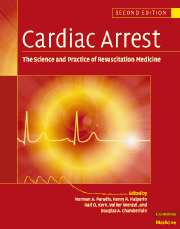Book contents
- Frontmatter
- Contents
- List of contributors
- Foreword
- Preface
- Part I Introduction
- Part II Basic science
- Part III The pathophysiology of global ischemia and reperfusion
- 12 The etiology of sudden death
- 13 Global brain ischemia and reperfusion
- 14 Reperfusion injury in cardiac arrest and cardiopulmonary resuscitation
- 15 Visceral organ ischemia and reperfusion in cardiac arrest
- 16 Mechanisms of forward flow during external chest compression
- 17 Hemodynamics of cardiac arrest
- 18 Coronary perfusion pressure during cardiopulmonary resuscitation
- 19 Methods to improve cerebral blood flow and neurological outcome after cardiac arrest
- 20 Pharmacology of cardiac arrest and reperfusion
- 21 Analysis and predictive value of the ventricular fibrillation waveform
- 22 Etiology, electrophysiology, and myocardial mechanics of pulseless electrical activity
- Part IV Therapy of sudden death
- Part V Postresuscitation disease and its care
- Part VI Special resuscitation circumstances
- Part VII Special issues in resuscitation
- Index
20 - Pharmacology of cardiac arrest and reperfusion
from Part III - The pathophysiology of global ischemia and reperfusion
Published online by Cambridge University Press: 06 January 2010
- Frontmatter
- Contents
- List of contributors
- Foreword
- Preface
- Part I Introduction
- Part II Basic science
- Part III The pathophysiology of global ischemia and reperfusion
- 12 The etiology of sudden death
- 13 Global brain ischemia and reperfusion
- 14 Reperfusion injury in cardiac arrest and cardiopulmonary resuscitation
- 15 Visceral organ ischemia and reperfusion in cardiac arrest
- 16 Mechanisms of forward flow during external chest compression
- 17 Hemodynamics of cardiac arrest
- 18 Coronary perfusion pressure during cardiopulmonary resuscitation
- 19 Methods to improve cerebral blood flow and neurological outcome after cardiac arrest
- 20 Pharmacology of cardiac arrest and reperfusion
- 21 Analysis and predictive value of the ventricular fibrillation waveform
- 22 Etiology, electrophysiology, and myocardial mechanics of pulseless electrical activity
- Part IV Therapy of sudden death
- Part V Postresuscitation disease and its care
- Part VI Special resuscitation circumstances
- Part VII Special issues in resuscitation
- Index
Summary
Introduction
The pharmacology of resuscitation is largely based on anecdotal evidence and descriptive research rather than on objective scientific experimentation. Our understanding of the pharmacokinetics (PK) and pharmacodynamics (PD) of drugs used to resuscitate victims of cardiac arrest is also limited by ethical and experimental constraints.
Animal models of cardiac arrest and cardiopulmonary resuscitation (CPR), jointly with clinical studies, have considerably increased our understanding of the pathophysiology of cardiac arrest and significantly improved our ability to resuscitate victims of cardiac arrest. The great majority of such studies, however, were designed to address interventions to improve resuscitation rather than to investigate the pharmacological profile of drugs used in settings of cardiac arrest and reperfusion. Even less evidence is available on the PK of administration of multiple drugs, a more complex but realistic scenario. During resuscitative efforts, i.e., low flow reperfusion, significant shunting of blood to vital organs occurs. The use of vasopressors in this setting further modifies the patterns of blood flow distribution, in all likelihood affecting the PK of concomitantly administered drugs.
The time from onset of cardiopulmonary arrest until restoration of an effective spontaneous circulation is the single most important determinant of long-term survival and neurological outcome. Prompt initiation of CPR and defibrillation of ventricular fibrillation (VF) or pulseless ventricular tachycardia (VT) are more likely to alter patient outcome than is pharmacologic management. Nevertheless, treatment with pharmacologic agents is frequently required in patients with VF or VT that is refractory to electrical shocks and in patients with asystole or pulseless electrical activity (PEA).
- Type
- Chapter
- Information
- Cardiac ArrestThe Science and Practice of Resuscitation Medicine, pp. 395 - 416Publisher: Cambridge University PressPrint publication year: 2007



